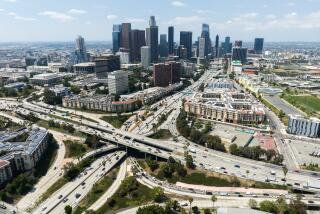Metrolink Upgrades on Track
- Share via
Two hours pass between the time Anne Nah leaves her South County home, drives to the Metrolink station in Irvine, boards the train and arrives at her mortgage company job in downtown Los Angeles.
Nah figures that the reduced stress on her nerves and her leased car make the trip worthwhile--except for Metrolink’s frequent unscheduled delays.
Rail traffic and other Metrolink problems--from inadequate parking to debris on the tracks--have added up to 40 more minutes to Nah’s long commute, sometimes wreaking havoc with her schedule. “There are a lot of delays between Union Station and Commerce” in Los Angeles County, she said.
Metrolink will spend much of its recently awarded $25.7 million in state funds to ease delays and congestion on the Orange County line by laying track, improving ticket machines and adding passenger cars by early 2001.
“The Orange County line continues to be the fastest-growing route on our system,” said Peter Hidalgo, Metrolink spokesman. “Currently, we see an average of 5,400 daily riders taking our trains from Oceanside to L.A.”
Ridership on the Orange County line is expected to grow 43% in the next four years and 137% by 2010, Hidalgo said. The 87-mile route, running from Oceanside to Los Angeles, stops at seven Orange County cities.
The regional agency will use $7 million to lay a three-mile stretch of track--similar to an extra freeway lane--in Commerce. The project would ease freight and passenger congestion on the nation’s second-busiest rail corridor mainly so that trains on the Orange County line can pass through more quickly. “This will make trains run more efficiently,” Hidalgo said. “The possibility of delays is greatly reduced.”
Metrolink--formally known as the Southern California Regional Rail Authority--also will spend $11.5 million of the state funds, plus about $42.5 million of other federal grant money, to buy 30 passenger cars. An undetermined number will be used on the Orange County line, and the rest will be added to the busiest of the 128 Metrolink trains that run in the six-county region every day.
Trains are so crowded now, says Michelle Baker of Foothill Ranch, that nearly every seat is taken on her trip home from Glendale Memorial Hospital, where she works once or twice a week.
“It’s more crowded during certain hours,” Baker said. “There’s always a seat, but people like to spread out a little after a long day’s work.”
They won’t have any room to spread out as ridership increases. By 2003 the Orange County line is expected to be carrying 7,700 commuters, and by 2010 it should have 12,800 patrons, Hidalgo said.
The authority also will use $1.6 million to improve ticket vending machines systemwide. Rail users will be able to buy Metrolink tickets in advance and buy tickets for other transit services, such as Amtrak.
“With the new enhancements, there will be flexibility,” Hidalgo said.
With the remaining money, Metrolink will spend $4.1 million for more parking and related improvements at the Van Nuys and Oxnard stations and $1.5 million for crossover tracks in Van Nuys and Glendale.
Some patrons think Metrolink ought to use its funds to provide more adequate parking at its stations. Wayne Saxton of Irvine said he missed his train to San Diego on Tuesday morning as he circled the Irvine station’s 630-space lot.
“Basically, there’s no overflow parking, and if you park somewhere else, you could get towed,” he said. “I drove to San Juan Capistrano and caught the train there, which was a real pain.”
Nah missed a train a few weeks ago because she too couldn’t find parking and had to drive to work. “It made me upset, because I have a monthly pass and I got here on time,” she said. Now, her husband drops her off on his way to work.
In separately funded projects elsewhere in Orange County, Metrolink stations are being built in Buena Park and Tustin and on the Laguna Niguel-Mission Viejo border. Hidalgo said the authority also hopes to obtain funding by 2003 to add a second set of tracks from Orange to Santa Ana and from Mission Viejo to San Juan Capistrano.
But some critics say Metrolink doesn’t attract enough patrons to justify spending more money on improving it.
“It’s a big sinkhole to lower money into,” said Wayne King, a director of Drivers for Highway Safety in Orange. “Metrolink hauls [a total of] 60,000 people per day. That’s way less than 1% of all [car] trips. It has no effect whatsoever on traffic, congestion or air pollution.”
He compared the 10 million daily car trips in Orange County, which include 300,000 on the Santa Ana Freeway alone, to the daily average of 5,400 riders on Metrolink’s Orange County line.
“It is zippo, nothing,” King said. “It’s invisible.”
The money would be better spent widening streets, synchronizing traffic lights or building bus turnouts, which allow mass transit vehicles to pick up passengers without blocking traffic.
Urban planners say the region needs transportation alternatives, but no one improvement will serve as a panacea.
“Given the projection of growth in Orange County over the next 40 years, we need to take advantage of every possible improvement in transportation and infrastructure that comes our way,” Mark Baldassare, a UC Irvine professor of urban planning, said last month.
More to Read
Sign up for Essential California
The most important California stories and recommendations in your inbox every morning.
You may occasionally receive promotional content from the Los Angeles Times.










